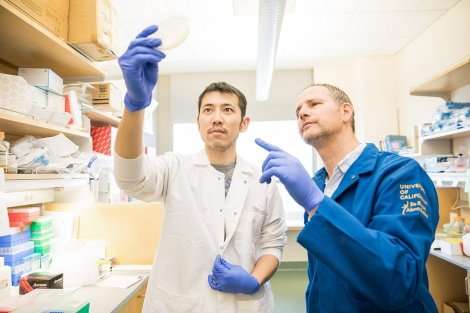How CRISPR tools are unlocking new ways to fight disease

Recent leaps in gene editing technology have brought ideas that just a decade ago seemed like science fiction to the cusp of reality.
The already famous CRISPR system allows scientists to edit faulty genes by cutting and replacing sections of DNA, but new and improved CRISPR techniques have expanded CRISPR's scalpel into a Swiss Army knife. The new tools give researchers more flexible control of gene function without permanently altering an organism's genetic code.
These versatile tools are helping to untangle the complex genetics underlying diseases such as cancer and autoimmune disorders. They could identify new targets for drug development or point the way for gene therapies that could one day target genetic defects related to blindness or obesity.
The basis of these new techniques, known as CRISPR-dCas9, was invented in 2013 by UC San Francisco researchers Jonathan Weissman, Ph.D.; Stanley Qi, Ph.D. (now at Stanford University); and Wendell Lim, Ph.D.
They took the CRISPR system, well-known for its ability to target and snip out pieces of DNA, and mutated the gene-cutting protein Cas9 to create dCas9. Variants known as CRISPRa (for activation) and CRISPRi (for interference) still target genes, but can swap in different molecular tools to dial up or down gene expression.
Lim, who is chair of the Department of Cellular and Molecular Pharmacology, likens dCas9 to a universal adapter that can recognize any gene through DNA base pairing, and then modulate that gene with protein attachments.
"CRISPR-dCas9 is a very powerful way of recruiting anything you want to any part of the genome," said Alexander Marson, MD, Ph.D., assistant professor of microbiology and immunology, one of many researchers who have adopted the new tools in their work.
Boosting Healthy Genes to Treat Obesity
In the lab of Nadav Ahituv, Ph.D., professor in the Department of Bioengineering and Therapeutic Science in the UCSF School of Pharmacy, researchers have shown in mice that it's possible to correct a genetic defect that causes severe obesity.
Healthy mice – and humans – have two copies of genes (one inherited from each parent). A defect in one copy that completely abolishes gene function, known as haploinsufficiency, can lead to disease. For example, mice with one defective copy of a particular gene involved in body weight tend to overeat and become obese. Ahituv realized that in this case, there was an opportunity for a potential therapeutic. "The trick here is you still have an existing copy that's fine," he said.
His team turned to CRISPRa, one of the CRISPR tools developed at UCSF, to target and boost the healthy copy of the gene, compensating for its broken twin. They packaged the CRISPRa system inside viruses that would deliver it into neuronal cells and injected the viruses into mice.
The treated mice stopped overeating and soon lost weight. When researchers examined the expression levels of the targeted gene, they found normal levels. Nine months later, the mice stayed at normal weight, and Ahituv says because neurons do not divide, the changes could last for the lifetime of the animal.
Haploinsufficiency for this obesity-related gene is responsible for a small percentage of cases of severe obesity in people. Considering the high rates of obesity in the U.S. population, even this small percentage represents quite a lot of people, says Ahituv.
His lab is now looking at five other haploinsufficient diseases, in particular at neurological and kidney diseases, as candidates for CRISPRa therapy, though much more work needs to be done before the technique can be tried in humans.
Researchers acknowledge they would have significant challenges to overcome in translating the new CRISPR tools into human therapies. A safe and precise delivery method would be key, as would a way to ensure the genetic changes are durable.
Revealing Hidden Switches
Even as these new CRISPR tools hint at new avenues for gene therapy, they're already opening the field for other therapies by revealing the complex genetic interactions that underlie diseases.
The most immediate payoff may be in identifying new therapeutic targets, according to Bruce Conklin, MD, professor of medicine at UCSF and senior investigator at Gladstone Institutes, who works with CRISPRi and related techniques in his research.
"The power of these techniques is to test thousands of different drug targets in a single experiment. This has already helped with leads for potentially useful drugs," he said.
It's estimated that 98 percent of our DNA does not code for proteins, but instead act as a switchboard for the 2 percent that do. These so-called promotors and enhancers can be cryptic and time-consuming to study with conventional genetic techniques.
With CRISPRa, Marson's lab can rapidly screen over 20,000 non-coding sites in the genome and study their function – essentially by flipping many switches and seeing which ones turn on the lights. "This is a critical step in identifying the functional significance of genetic elements," said Marson.
In a recent CRISPRa screen, Marson's lab, in collaboration with the lab of Jacob Corn, Ph.D., at UC Berkeley, identified several enhancers associated with inflammation and autoimmune disorders. In fact, one of the newly identified enhancers matched a common genetic variant known to increase the risk of irritable bowel disease, although its mechanism had previously been a mystery.
Lim has watched the CRISPR-dCas9 methods he helped pioneer disperse to research labs around the world in just a few years. From 2013 to the end of 2015, 49 papers included the term dCas9 in their title or abstract, according to PubMed. From 2016 through June 2018, 242 papers cited the same term – a nearly five-fold increase.
"It is amazing how quickly this technology has spread within just a few years." said Lim. "It speaks to how flexible the simple core concept is."
Provided by University of California, San Francisco





















